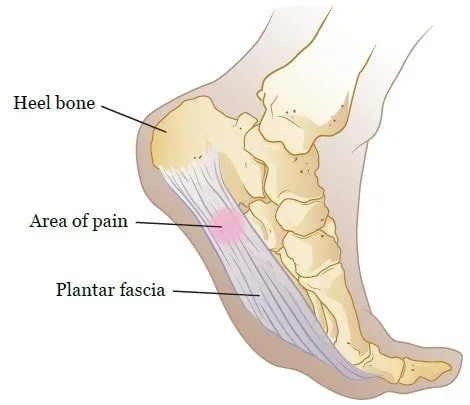Botox for Plantar Fasciitis: An Advanced Non-Surgical Treatment for Heel Pain
If you have ever felt heel pain that would not subside, you may be suffering from plantar fasciitis. This physical condition affects numerous people across the world. Traditional treatments include stretching, orthotics, and anti-inflammatory medicines. These treatments work for many people, but some still experience persistent pain. Botox for plantar fasciitis has shown promise in easing heel pain by reducing inflammation and relaxing tight muscles.
What is Plantar Fasciitis?
Whenever the plantar fascia - a thick, fibrous band of tissue running along the sole of the foot from the heel to the toes - gets swollen or irritated, it leads to a physical condition called plantar fasciitis. This can cause chronic heel pain, especially in the morning after waking up from sleep, or after prolonged standing. Some of the symptoms of this condition are:
· Stabbing or sharp heel pain, particularly in the morning
· Pain that aggravates with prolonged activity or standing
· Tenderness and swelling in heel area
Causes of Plantar Fasciitis?
Several factors can cause plantar fasciitis, including:
· Strenuous activities that cause pain and irritation in the plantar fascia
· Shoes that do not provide adequate arch support
· Excessive strain on the ankle and foot, often from prolonged standing or running
If left untreated, plantar fasciitis can impact daily activities significantly. This is why plantar fasciitis treatment with Botox is considered innovative and effective.
What is Botox for Plantar Fasciitis?
Botox has traditionally been used for both medical and cosmetic purposes, but a recent study has demonstrated that Botox injections for plantar fasciitis can effectively decrease heel pain and enhance foot function. Botox treatment relaxes the plantar fascia by decreasing excessive tension, which in turn helps reduce inflammation.
The treatment interrupts the nerve signals responsible for muscle contraction, which eases pain and reduces tightness. Studies have shown that Botox has reduced the requirement for invasive treatment such as plantar fasciotomy, and experts say Botox may yield better long-term relief than steroid injections.
Benefits of Botox for Plantar Fasciitis
Some of the benefits of Botox for plantar fasciitis are:
This is a safe procedure with no significant risks involved.
Reduces healing time. If plantar fasciitis is left untreated, it could take 18 months to heal.
Helps in improving patients’ response to physical therapy: the muscles around the Botox‑treated area can strengthen without overloading the treated muscles, which helps decrease pressure on sensitized tissues.
Comparatively inexpensive treatment.
Major studies have demonstrated that Botox treatment for plantar fasciitis is up to 70 percent effective.
One-time treatment.
Fast treatment (less than one minute).
Procedure pain is negligible (a small needle is used, and only one or two insertion sites are needed).
How Botox Injections for Plantar Fasciitis Work?
Botox injection or a similar neuromodulator, such as Xeomin, relaxes the tight muscle on the sole of the foot that attaches to the front underside of the heel. The muscle’s pull causes pain and irritation at the attachment site of the fascia to the bone. Over time, this repeated stress can also lead to the formation of bone spurs. After Botox relaxes the muscle, it stops the continual tug between muscle and fascia, and between fascia and bone. This reduces pain and gives the injured area a chance to heal.
Preparation for Botox Injections for Plantar Fasciitis
No prior preparation is needed for this procedure. Nevertheless, it is a good practice to clean the feet to decrease the risk of infection, which may occur from needle puncture on the skin. Avoiding blood-thinning agents like fish, alcohol, oils, and pain medications such as Aleve, Motrin, Ibuprofen, and Advil can help minimize bleeding during the treatment or bruising afterward.
Refrain from alcohol consumption 24 hours before the procedure, and avoid Botox treatment for plantar fasciitis during pregnancy or while breastfeeding, since its safety in those situations has not been established. Moreover, discuss your health issues with your physician ahead of time.
What to Expect During the Administration of Botox Injections for Plantar Fasciitis?
The medical aesthetician will evaluate your existing health to make sure you are fit for this procedure
The injection area will be cleaned and prepared before the treatment
To provide comfort to the people, cold air blowing device, vibration devices, ice, or topical creams are provided
A small needle will be inserted in the targeted area, and Botox shots will be administered at one or two sites
The treatment area will be covered with a first aid bandage, after which you will be released
Botox Treatment for Plantar Fasciitis: Aftercare and Recovery
After the procedure, you should try to limit your walking for four hours, as movement or pressure may cause the Botox to spread into adjacent areas. While the spread will not be harmful, preventing it will give you more effective results that last longer.
Side Effects Associated with Botox Treatment for Plantar Fasciitis
The treatment has rarely any serious adverse effects. Some of the common mild side effects associated with this procedure are:
Reduced ability to curl the toes downward
Bruising
Infection
Bleeding



